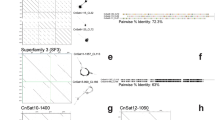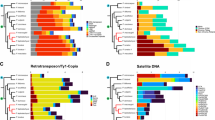Abstract
A clone of highly repetitive DNA, designated C5, was isolated from DNA of female Chinese muntjac cells. The nucleotide sequence of this clone is 80%–85% homologous to that of the satellite IA clone and other highly repetitive DNA clones previously obtained from the Indian muntjac. Using C5 as a probe for in situ hybridizations to chromosome preparations of cells of both the Chinese and Indian muntjacs, we were able to show that these repeated sequences occur in centromeric heterochromatin of the chromosomes of both Chinese and indian muntjac species. More significantly, non-random clusters of hybridization signals were detected on the arms of chromosomes of the Indian muntjac. These latter hybridization sites are postulated to be regions of interstitial heterochromatin and could be the remnants of centromeric heterochromatin from ancestral Chinese muntjac chromosomes. Our observations provide new supportive evidence for the tandem chromosome fusion theory that has been proposed for the evolution of the Indian muntjac karyotype.
Similar content being viewed by others
References
Bogenberger JM, Schnell H, Fittler F (1982) Characterization of X-chromosome specific satellite DNA at Muntiacus muntjac vaginalis. Chromosoma 87: 9–20
Bogenberger JM, Neumaier PS, Fittler F (1985) The muntjak satellite IA sequence is composed of 31-bp-pair internal repeats that are highly homologous to the 31-base-pair subrepeats of the bovine satellite 1.715. Eur J Biochem 148: 55–59
Brinkley BR, Valdivia MM, Tousson A, Brenner SL (1984) Compound kinetochores of the Indian muntjac: evolution by linear fusion of unit kinetochores. Chromosoma 91: 1–11
Chen ZQ, Lin CC, Hodgetts RB (1989) Cloning and characterization of a tandemly repeated DNA sequence in the crane family (Gruidae). Genome 32: 646–654
Comings DE (1971) Heterochromatin of Indian muntjac. Exp Cell Res 67: 441–460
Elder FFB, Hsu TC (1988) Tandem fusions in the evolution of mammalian chromosomes. In: Sandberg AA (ed) The cytogenetics of mammalian autosomal rearrangements. A.R. Liss, New York, pp 481–506
Fan YS, Davis LM, Shows TB (1990) Mapping small DNA sequences by fluorescence in situ hybridization directly on banded metaphase chromosomes. Proc Natl Acad Sci USA 87: 6223–6227
Feinberg AP, Vogelstein B (1983) A technique for radiolabelling DNA restriction endonuclease fragments of high specific activity. Anal Biochem 132: 6–13
Feinberg AP, Vogelstein B (1984) Addendum. Anal Biochem 137: 266–267
Horz W, Altenburger W (1981) Nucleotide sequence of mouse satellite DNA. Nucleic Acids Res 9: 683–696
Johnson GD, deNogueira C, Aranjo JGM (1981) A simple method for reducing the fading of immunofluorescence during microscopy. J Immunol Methods 43: 349–350
Johnston FP, Church RB, Lin CC (1982) Chromosome rearrangement between the Indian muntjac and Chinese muntjac is accompanied by a deletion of middle repetitive DNA. Can J Biochem 60: 497–506
Lin CC, Meyne J, Sasi R, Bowen P, Unger T, Tainaka T, Hadro TA, Hoo JJ (1990) Determining the origin and structural aberrations of small marker chromosomes in two cases of 45,X/46,X,+mar by use of chromosome-specific DNA probes. Am J Med Genet 37: 71–78
Manuelidis L, Wu JC (1978) Homology between human and simian repeated DNA. Nature 276: 92–94
Masumoto H, Masukata H, Muro Y, Nozaki N, Okazaki T (1989) A human centromere antigen (CENP-B) interacts with a short specific sequence in alphoid DNA, a human centromeric satellite. J Cell Biol 109: 1963–1973
Moyzis RK, Buckingham JM, Cram CS, Dani M, Deaven LL, Jones DJ, Meyne J, Ratcliff RL, Wu JR (1988) A highly conserved DNA sequence, (TTAGGG)n, present at the telomeres of human chromosomes. Proc Natl Acad Sci USA 85: 6622–6628
Nederlof PM, Robinson D, Abuknesha R, Wiegant J, Hopman AHN, Tanke HJ, Raap AK (1989) Three-color fluorescence in situ hybridization for the simultaneous detection of multiple nucleic acid sequences. Cytometry 10: 20–27
Plucienniczak A, Skowronski J, Jaworski J (1982) Nucleotide sequence of bovine 1.715 satellite DNA and its relation to other bovine satellite sequences. J Mol Biol 158: 293–304
Rattner JB (1986) Organization within the mammalian kinetochore. Chromosoma 93: 515–520
Sasi R, Hoo JJ, Samuel IP, Taninaka T, Shiferaw S, Lin CC (1991) Chromosome aberrations and oncogene alternations in two new breast tumor cell lines. Cancer Genet Cytogenet 51: 239–254
Scherthan H (1990) Localization of the repetitive telomeric sequence (TTAGGG)n in two muntjac species and implications for their karyotypic evolution. Cytogenet Cell Genet 53: 115–117
Schmidtke J, Brennecke H, Schmid H, Neitzel H, Sperling K (1981) Evolution of Muntjac DNA. Chromosoma 84: 187–193
Shi LM, Ye YY, Duan XS (1980) Comparative cytogenetic studies on the red muntjac, Chinese muntjac and their F1 hybrids. Cytogenet Cell Genet 26: 22–27
Sumner AT (1972) A simple technique for demonstrating centromeric heterochromatin. Exp Cell Res 75: 304–305
Wurster DH, Benirschke K (1967) Chromosome studies in some deer, the springbok and the proghorn, with notes on placentation in deer. Cytologia 32: 273–285
Wurster DH, Benirschke K (1970) Indian muntjac, Muntiacus muntjak: A deer with a low diploid chromosome number. Science 168: 1364–1366
Wurster-Hill DH, Seidel B (1985) The G-banded chromosomes of Roosevelt's muntjac, Muntiacus rooseveltorum. Cytogenet Cell Genet 39: 75–76
Yu LC, Lowensteiner D, Wong EFK, Sawada I, Mazrimas J, Schmid C (1986) Localization and characterization of recombinant DNA clones derived from the highly repetitive DNA sequences in the Indian muntjac cells: Their presence in the Chinese muntjac. Chromosoma 93: 521–528
Author information
Authors and Affiliations
Additional information
by P.B. Moens
Rights and permissions
About this article
Cite this article
Lin, C.C., Sasi, R., Fan, Y.S. et al. New evidence for tandem chromosome fusions in the karyotypic evolution of Asian muntjacs. Chromosoma 101, 19–24 (1991). https://doi.org/10.1007/BF00360682
Received:
Accepted:
Issue Date:
DOI: https://doi.org/10.1007/BF00360682




